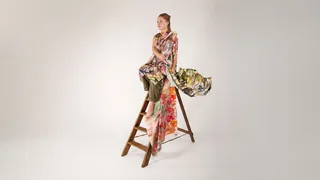One of the exhibitors at Ocean Talks 2025 is Joanne O'Rourke, an eco-textile designer who hand-paints materials with natural dyes made from marine plants. Ahead of the event, O'Rourke tells BOAT about the brand's story.
1. What makes your textiles so unique?
My textiles are created through a layered process that brings together eco-friendly materials, handcraft and low-impact innovation. I begin by hand painting with eco dyes, including pigments extracted from natural seaweed, to create expressive, one-off artworks. These are scanned and lightly refined before being printed onto deadstock fabrics using eco inks and waterless dye technology - preserving painterly detail while reducing environmental impact.
I also work directly with real seaweed, brushing it with eco inks or dye and pressing it onto fabric to capture the intricate forms of marine life. I incorporate shibori pole-wrapping, a traditional resist dye technique, using a natural indigo vat to add layered pattern and depth. Each piece is shaped by nature, slowness and a commitment to sustainable practice.
2. What inspired you to create them?
I have always been drawn to the quiet complexity of coastal and marshland ecosystems. There is something meditative about working slowly and by hand - it helps me connect more deeply with the materials and the landscapes they come from. Using seaweed, natural pigments and traditional dye methods, I create textiles that hold memory - not just of imagery, but of rhythm, movement and place.
3. You create textiles printed directly from seaweed using imprints of marine plants - what first inspired you to do this?
It began when I boiled a piece of seaweed to explore its potential as a natural dye. That simple experiment opened up a deeper curiosity - I became fascinated by its colour, texture and potential as a raw material. I started imprinting real seaweed directly onto fabric using eco inks, and that moment sparked my TideMark process - a way of preserving the delicate forms of marine life through touch, texture and pigment.
As the work evolved, I began experimenting with seaweed as a biomaterial, blending it with ingredients like spirulina and biochar to explore new surface applications. What excites me most is that seaweed is naturally regenerative - it does not require land, freshwater or fertilisers to grow, and it actively absorbs carbon and excess nutrients from the ocean. When harvested responsibly, seaweed can support marine ecosystems and offer a radically more sustainable path for design and material innovation.
4. Can you walk us through your creative process?
It begins with sustainable foraging - I collect washed-up seaweed and sketch or hand paint using eco-friendly dyes. I brush natural inks directly onto the seaweed and press it onto the fabric to preserve its texture and form. I then scan the work for subtle digital refinement and print it onto deadstock cloth using waterless dye methods. Alongside this, I work with shibori pole-wrapping in a natural indigo vat, layering visual language and meaning through traditional resist techniques. Each piece becomes a quiet collaboration between craft, ecology and time.
5. Have you encountered any challenges?
Absolutely. Seaweed is sensitive - it changes with the tide, the season and how long it is been out of the water. Indigo dyeing is delicate and can be unpredictable. Balancing these organic methods with digital refinement, while staying true to sustainability, is a constant process of adaptation. But that is also what keeps the work alive - it is always evolving with the materials.
6. How did your collaboration with the Hyatt Regency Hotel come about, and what was that experience like?
Through Norwich University of the Arts, I was invited to exhibit a textile and painting at the Hyatt Regency Hotel. The work focused on marshland biodiversity, created using my natural dye painting process. It was meaningful to bring that kind of hand-crafted, nature-connected work into a hospitality space - a place where people could slow down and engage with materials that carry memory and care.
7. You are interested in pushing the boundaries of textile design - what's next on your list?
I am developing a collection of wall fabrics and sustainable textiles using my seaweed imprint and eco-dye methods. These are intended for slow, thoughtful interiors - spaces where materials matter. I am also researching seaweed-based biomaterials and experimenting with natural composites for surface and sculptural use. My work is moving towards small-batch pieces, and I am open to exploring how these materials can continue to bridge design, ecology and well-being.
8. What will you be exhibiting at Ocean Talks?
At Ocean Talks, I will be presenting TideMark - a collection of textiles created through seaweed imprinting, eco painting and natural indigo dyeing. The collection includes large fabric panels, interior textile samples and digitally refined cloth printed with waterless technology on headstock fabric. These are tactile, emotional surfaces - inviting people to pause, look closely and reflect on the ocean's quiet strength and fragility. Some of the floral pieces suggest underwater biodiversity - expressive, flowing forms that echo coral, algae and submerged gardens. I am also exploring ways to translate these designs into interior products and a future clothing range, staying rooted in slow craft, natural materials and environmental care.
9. If you could share one key message about ocean conservation, what would it be?
The ocean is not separate from us - it sustains us every day. My practice uses low-water, low-impact methods, circular materials and craft processes that respect that connection. As a member of Green Grads UK, I believe design must go beyond aesthetics and actively participate in ecological care. We protect what we feel connected to - and design has the power to help us feel.
Now in its eighth year, Ocean Talks will return to London on 12 June 2025, celebrating ocean conservation efforts in the week running up to World Oceans Day. Tickets are free but guests must register their attendance.
GET A TICKETRead More/Everything you need to know about Ocean Talks 2025
